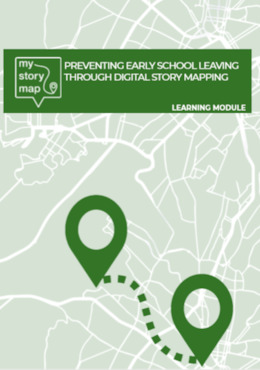Toolbox — For Training and Youth Work
All new tools in your inbox: Be the first to know about new tools for learning with our e-mail notifications.
Manual
Preventing Early School Leaving through Digital Story Mapping
The booklet is targeting teachers and other professionals working with young people at risk of drop out. It offers tools to integrate non-formal learning within the didactic curriculum through the use of digital story-mapping
Aims of the tool
The learning module aims to provide guidance and orientation for teachers in order to be able to develop a multi-session module that integrates elements of non-formal learning through the methodology of digital story-mapping within the didactic curriculum. The module aims to promote in the students a sense of ownership and re-appropriation of the educational content and the learning experience, through the process of creation of a digital story-map on a given topic and/or subject chosen by the teacher from the educational curricula.
Description of the tool
The use digital story-maps represents a different way of learning in which students get involved and act first hand using their experience and creativity to construct their own learning process, using their knowledge and skills to create products such as photos, videos, digital stories, multimedia presentations which can enrich their curriculum. Thanks to a process of interactive participation through which is easier to observe, learn, process, explain and memorize concepts, students are made the protagonists of the didactic action.
In the module, the teacher has the task of creating, through a collaborative didactic approach based on group and/or individual work, the learning units that serve as a basis for personal study. It does so by working on the concept of self-directed learning where the student, once the topic has been selected, is the one who is in charge of designing what could be one’s own personal re-elaborated version of the topic through means of expression related to the world of digital technology. In this way the student learns to deconstruct a set of information and then reconstruct it on the basis of one’s own logical connections and intuition, searching for one’s own learning style.
The content of the booklet is organized and divided into five main parts:
- the pedagogical framework, which sets the premises of the didactic approach envisioned by the module;
- the methodology of digital story-mapping, providing an overview and the deepening of the main working tool to be adopted during learning experience with the students;
- the overview of the module in terms of approach and structure, accompanied by the main guidelines for implementation;
- the learning objectives, looking at the identified competences to be developed through the module and contextualising them into the frame of the work on digital story-mapping applied to Early School Leaving;
- the evaluation strategy to be adopted in the module addressing both teachers and students;
- the outline of all the learning materials for the face-to-face sessions which have been selected in order to respond and address the identified learning objectives, divided according to the content and purpose of each specific learning phase.
Starting from the intuition that the most delicate moment of the didactic process is not accessing the content but their application and re-elaboration, the reversed, upside-down teaching approach presented in the module represents an opportunity to redefine the role of the teachers. Here the teacher, rather than indiscriminately introducing notions not assimilated by all in the same way, takes on a more complex role that supports the "extraction” of the potential from each student. Within the module, teaching that fosters motivation to learn is a thoughtful process of aligning student choices so that students see the value of these choices as tools for meeting their learning needs and goals.
Available downloads:
Disclaimer
SALTO cannot be held responsible for the inappropriate use of these training tools. Always adapt training tools to your aims, context, target group and to your own skills! These tools have been used in a variety of formats and situations. Please notify SALTO should you know about the origin of or copyright on this tool.
Tool overview

http://toolbox.salto-youth.net/2847
This tool is for
Young people at risk of drop out
and addresses
Personal Development, Peer education
It is recommended for use in:
Strategic Partnerships
Duration:
The implementation structure of the module is designed to cover a total from 15 to 25 hours for the entire learning curriculum, including hours dedicated to individual and autonomous students’ study and production at home. The module is suitable to be implemented in either an individual or a collective framework
Behind the tool
The tool was created by
MY STORY MAP international consortium: IISS PIAGET DIAZ (Italy), REPLAY NETWORK (Italy), PISTES SOLIDAIRES (France), ASOCIACION MUNDUS (Spain), EUROGEO (Belgium), DIE BERATER (Austria)
in the context of
The learning modules are the result of the 2 years ERASMUS+ KA2 School Strategic Partnership project MY STORY MAP, realized by a consortium of schools and non formal education organisations.
The tool has been experimented in
My Story Map project, KA2 School
The tool was published to the Toolbox by
ANDREA MESSORI (on 27 April 2020)
and last modified
27 April 2020
Comments
No comments have been posted yet.
If you want to comment on this tool, you need to be signed in with your MySALTO account. Sign in now